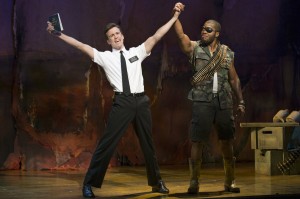Mormon thrills at the Pantages
An L.A. audience has never been as excited to hear a doorbell as in the opening moments of The Book of Mormon at the Pantages Theater. As the show draws palpable energy from crowds lucky enough to get tickets to an early show, its run until Nov. 25 looks promising.

Missionary matters · Gavin Creel (left) stars as Elder Price in the The Book of Mormon. When the Mormon missionaries arrive in Uganda, they quickly learn that the villagers aren’t receptive to converting to Mormonism. – | Photo courtesy of Joan Marcus
At its heart, The Book of Mormon is a coming-of-age tale centered around two mismatched companions and their journey to accept each other. What makes Mormon different from other shows, though, is that the companions are Mormon missionaries, and the play is mostly an in-your-face discussion of faith and whether or not it makes any sense.
Once the idea of a controversial musical fades, however, the audience is left with a truly spectacular show that deserves all the hype and craze that has been following it on its first national tour.
Gavin Creel as the seemingly perfect missionary Elder Price is a huge draw for the show because of his extensive history of playing big name roles such as Claude in Hair and Bert in Mary Poppins. Creel doesn’t disappoint in his latest show. In “I Believe,” his chops as a musical theater actor shine through, and his persona makes the character of Elder Price funny, over-the-top obnoxious and then relatable, all within a 2 1/2 hour show.
Price’s companion is the dim-witted but lovable Elder Cunningham, played by Jared Gertner, who is fresh off the Broadway show. During “Man Up,” Elder Cunningham sings “time to stand up and steal the show,” and Gertner certainly does. His energy and comedic timing earn applause and laughter throughout the performance.
Together, elders Price and Cunningham are sent to Uganda to convert Africans to Mormonism. There, they quickly learn that the tactics taught at “mission control center” aren’t what villagers need to combat AIDS, warlords and famine, leading them to question if their faith is the answer for the villagers — or for themselves.
While the two leads are spectacularly cast and perform with admirable vigor, Samantha Marie Ware’s performance as villager Nabulungi (or Neutrogena or Neosporin, depending on how Elder Cunningham is trying to pronounce her name) is a true gem of Mormon. Her “Sal Tlay Ka Siti” performance has sincerely funny moments, but unlike other songs that get big laughs and knee slaps, the audience is virtually silenced by the power of her voice, not wanting to interrupt or taint a moment so beautiful until her final note.
One of the most exciting aspects of the show is that it constantly keeps you guessing. “Turn It Off” starts out as a fairly standard number, and suddenly, with clever lighting design distractions, the cast is in pink sequined vests and performing an elaborate tap dance. Thematic surprises also filter into numbers, like in “Spooky Mormon Hell Dream” when Elder Price is haunted by dancing Starbucks cups, and Johnnie Cochran. This sequence also features the show’s most elaborate choreography with actors in skeleton costumes performing with top hats and canes.
The intricate choreography shifts also play into the incredibly smart set changes, as during “You and Me (But Mostly Me).” In this scene, Elder Price sends Elder Cunningham off the stage as the set literally collapses around him, leaving Elder Price alone on the stage to shine in his own spotlight and belt out the final notes of the song.
The show and its creators, Matt Stone and Trey Parker (South Park) and Robert Lopez (Avenue Q), have dealt with a lot of criticism about the show’s content — the show has even been called blasphemous — but those critics are completely missing the point of the show.
Still, with Mormon’s coarse material, it’s easy to see why. Easily the most blatantly “offensive” song is “Hasa Diga Eebowai” as elders Price and Cunningham learn that this village’s version of “Hakuna Matata” isn’t exactly PG, but gives an opportunity to vent their frustrations by “rais[ing] your middle finger … and curs[ing] His rotten name.”
Nevertheless, despite the scene’s “explicit” content, the thesis of the show appears in full force.
In what Parker and Stone have called “a love letter to religion,” this show suggests that religion isn’t stupid, but can be used as a coping mechanism and a tool to explain the world. In the end, if that’s what you need to get through the day and be a good person, then what’s the big deal? Who cares if it makes sense or not?
To see for yourself, check out the show, but if you can’t get tickets to the nearly sold out shows, “just throw [your] hands to the sky and say, ‘Hasa Diga Eebowai’.”
